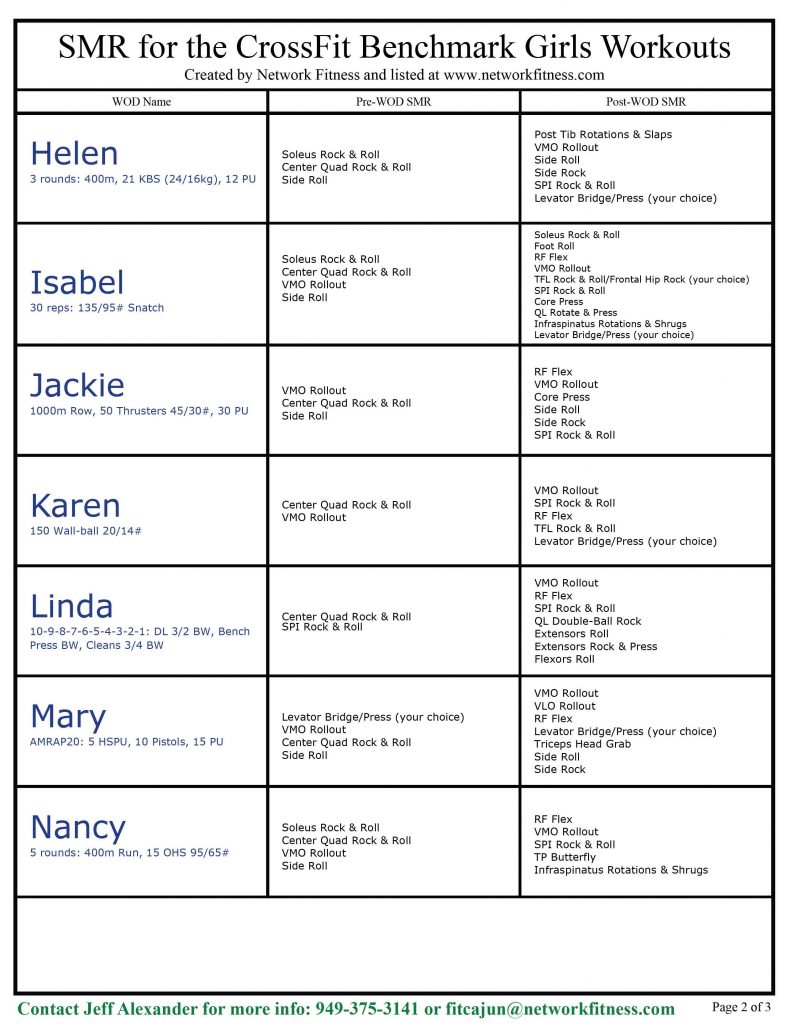|
After years of requests from the CrossFit community, we now have a list of the SMR movements for each of the benchmark named workouts. Feel free to download the Adobe PDF and print or email it to share with whomever you choose. We want you to perform better so that you can raise the level of competition out there. 3-2-1...GO! Click here to download the CrossFit Named WODs (as of 6-12-2011) |
|
Click here to download the list of SMR for the Girls Pre-WOD SMR should be done prior to your dyanamic warm up and practice movements. Remember, the purpose of SMR is to "turn off" stubborn, overly tight muscles. You want everything awake when you try to crush Fran or any other WOD. Post-WOD SMR should be done following your cool down stretches, as your heart rate returns to normal. Do the rolling movements at the gym, and the ball exercises much later when you have completely cooled down. You don't want to significantly restrict blood flow right after your WOD, and the localized pressure possible with the ball is likely to be too much to ensure adequate blood flow while you are lying on top of it. Take your time, breathe deeply, and focus on allowing your muscles to wrap around the ball or roller. Good luck! |
|
Click here to download the list of SMR for the Heroes Pre-WOD SMR should be done prior to your dynamic warm up and practice movements. Remember, the purpose of SMR is to "turn off" stubborn, overly tight muscles. You want everything awake when you try to crush Murph or any other WOD. Post-WOD SMR should be done following your cool down stretches, as your heart rate returns to normal. Do the rolling movements at the gym, and the ball exercises much later when you have completely cooled down. You don't want to significantly restrict blood flow right after your WOD, and the localized pressure possible with the ball is likely to be too much to ensure adequate blood flow while you are lying your body on top of it. Take your time, breathe deeply, and focus on allowing your muscles to wrap around the ball or roller. Good luck! (The pictures below include the 20 pages in the printable Adobe PDF linked above.) |
Tag: CrossFit
Soleus work for tight calves
Here is some raw footage from a SMR Coaches Clinic at CrossFit One World.
Interview with Jeff: What is SMR?
This short interview was conducted just prior to the SMR Coaches Clinic at CrossFit Invictus in San Diego. Jeff was asked to describe what SMR is, and why would you want to do it. He gives brief explanations to the science and methodology of self-myofascial release. If you aren't doing it, you should be! Watch the video to learn more.
Bike Wear World filmed this interview. They're big fans of SMR, and Jeff appreciates their help promoting it to the public. Thanks, Sami!
Want to share this video? Look below for the URL and the embedding script.
URL :
http://www.youtube.com/watch?v=aJUz4xvnHXs&feature=player_embedded























